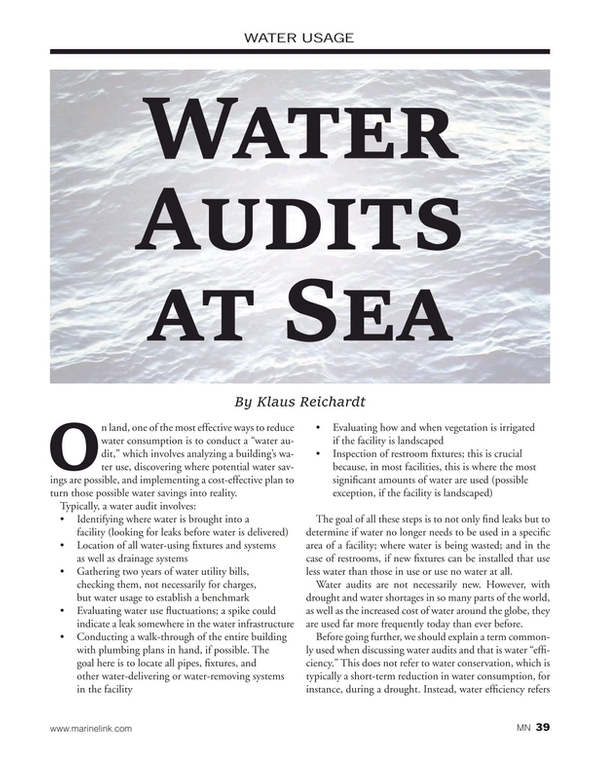
Water Audits at Sea
On land, one of the most effective ways to reduce water consumption is to conduct a “water audit,” which involves analyzing a building’s water use, discovering where potential water savings are possible, and implementing a cost-effective plan to turn those possible water savings into reality.
Typically, a water audit involves:
- Identifying where water is brought into a facility (looking for leaks before water is delivered)
- Location of all water-using fixtures and systems as well as drainage systems
- Gathering two years of water utility bills, checking them, not necessarily for charges, but water usage to establish a benchmark
- Evaluating water use fluctuations; a spike could indicate a leak somewhere in the water infrastructure
- Conducting a walk-through of the entire building with plumbing plans in hand, if possible. The goal here is to locate all pipes, fixtures, and other water-delivering or water-removing systems in the facility
- Evaluating how and when vegetation is irrigated if the facility is landscaped
- Inspection of restroom fixtures; this is crucial because, in most facilities, this is where the most significant amounts of water are used (possible exception, if the facility is landscaped)
The goal of all these steps is to not only find leaks but to determine if water no longer needs to be used in a specific area of a facility; where water is being wasted; and in the case of restrooms, if new fixtures can be installed that use less water than those in use or use no water at all.
Water audits are not necessarily new. However, with drought and water shortages in so many parts of the world, as well as the increased cost of water around the globe, they are used far more frequently today than ever before.
Before going further, we should explain a term commonly used when discussing water audits and that is water “efficiency.” This does not refer to water conservation, which is typically a short-term reduction in water consumption, for instance, during a drought. Instead, water efficiency refers to a long-term reduction in water consumption.
If all goes well and the audit does uncover areas where water consumption can be reduced, this can prove to be a significant cost saving for the facility. Further, we should add there can be energy savings as well because it takes electricity to deliver water to and from a facility.
How About at Sea?
Realizing these possibilities, the question should be asked if maritime operators can also benefit by conducting a water audit on their vessels. And if they could, how? To answer this question, let’s first look at why smaller maritime vessels such as ferries or small cruise ship would want to conduct a water audit. Among the reasons would be the following:
- Water is heavy. One gallon of water weighs just over eight pounds. If a small vessel carries 500 gallons of water, that water would weigh more than 4,000 pounds. This added weight means more fuel must be consumed by the boat for it to operate. If a water audit finds ways to reduce this amount, less fuel will be necessary.*
- Fuel cost savings. Less fuel means expenditures for fuel will be reduced.
- Water cost savings. There is no “average” cost for water in the U.S. and most parts of the world. On top of water charges, many localities will tack on taxes and fees. Needless to say, if the vessel does not need to purchase as much water, cost savings will materialize.
- Blackwater Pumping Costs. Blackwater usually refers to the collection of solid waste, which is pumped and collected into blackwater tanks. Less water used means less pumping when in harbor, the cost of which have steadily risen over the years.
- Sustainability. The entire cruise ship and shipping industry are looking for ways to become a much more sustainability focused. Reducing the amount of water necessary for operation, along with the amount of fuel needed for operation, addresses two key sustainability goals of the entire industry.
- Storage. Space is invariably at a premium on most smaller vessels. If less water is necessary, space can be freed up for other purposes.
Conducting an Onboard Water Audit
Many of the same steps mentioned earlier that are part of a water audit in a building would apply to a small vessel. For instance, leaks can be a big problem. This is because the high humidity can cause metal fittings to rust and weaken, resulting in leakage. This is also true in tanks where water is stored.
A “plumbing map” will also prove helpful in a small vessel water audit. Once again, knowing where all pipes, fixtures, water-delivering, and water removal outlets are located helps ensure the examination is conducted thoroughly.
When it comes to leakage, some of the items that should specifically be checked on a small vessel include the following:
- All water carrying piping materials, fittings, joints, and connections
- Drinking water fixtures
- Water pumps
- Air conditioning units
Beyond leakage, we must look to see if the water is being used in any areas of the vessel where it can be reduced or is no longer necessary. We referenced this earlier and it is surprisingly common to find this happening in industrial facilities. It may also be true on larger, older vessels.
We should also note that evaporation can also play a role in water waste. While this can vary due to the age of the vessel, humidity, air velocity, temperature, and other factors, it can and does happen. Taking steps to minimize or eliminate evaporation helps ensure water is used for its intended purposes and not lost to vapor.
Water Efficiency
We mentioned water efficiency earlier and indicated that this refers to long-term water reduction. Some of the steps that buildings take to ensure water efficiency can prove valuable to small vessels as well. For instance, HVAC systems are invariably checked. Most older systems allow too much water to evaporate in the cooling process. The same can be true of HVAC systems on ferries and smaller vessels.
Further, the kitchen and bathroom fixtures should all be examined. If faucets or showers are older or appear to be using large amounts of water, they do not need to be replaced. Very inexpensive aerators installed in faucets and shower heads can reduce water consumption by as much as 50%. Further, this can also reduce energy costs significantly because less water is needed for heating.
Toilets and urinals should also be checked. Smaller ships typically have both vacuum and gravity systems, using either fresh- or salt- water to remove waste. Because the vacuum on a vacuum system does all the work at removing waste, less water is used than with gravity systems.
However, if a vacuum system malfunctions, mechanical and maintenance problems can occur. Further, gravity systems powered by salt water may need to be hydro blasted to remove rust and encrustation stains, which can be costly. So, for both systems, if less water can be used, the benefits are manifold.
- No-water or waterless urinals should also be considered. These urinals provide the following savings:
- No water is need for the urinal to operate, which can reduce installation costs.
- On land, these urinals can save up to 35,000 gallons of water per urinal per year
- Drain line encrustations are reduced and therefore maintenance costs.
- Less water use also means a more hygienic environment; bacteria and many pathogens require moisture in order to develop and grow
Benefits?
Hopefully, we have made the case for conducting a water audit for smaller vessels. The key benefits, along with water savings, are cost savings. With thin profit margins for some carriers, this can prove to be an essential factor and reason for conducting a water audit.
However, we cannot overlook the sustainability movement happening around the world. Just like every other industry, the shipping industry, even small ships, are going to be expected to do their part. Conducting a water audit and eliminating water waste will help accomplish this.
*This is a ballpark estimate. More than 260,000 gallons of water are used per day on a typical passenger cruise ship
 Klaus Reichardt is CEO and founder of Waterless Co, Inc, Vista, Calif. Reichardt founded the company in 1991 with the goal of establishing a new market segment in the plumbing fixture industry with water efficiency in mind. Reichardt is a frequent writer and presenter, discussing water conservation issues. Klaus Reichardt is CEO and founder of Waterless Co, Inc, Vista, Calif. Reichardt founded the company in 1991 with the goal of establishing a new market segment in the plumbing fixture industry with water efficiency in mind. Reichardt is a frequent writer and presenter, discussing water conservation issues. |
Read Water Audits at Sea in Pdf, Flash or Html5 edition of January 2020 Marine News
Other stories from January 2020 issue
Content
- Red and White and Green All Over page: 12
- Fishing for Trouble page: 16
- An Ever-vigilant Focus on Passenger Vessel Safety page: 18
- Ferry Industry Sets Pace on Critical Solutions page: 20
- Vessel Safety: US House Subcommittee Seeks Faster Implementation page: 24
- Vessel Inspections: It's All About Safety page: 28
- Safely Navigating the Winds of Change page: 34
- Water Audits at Sea page: 39
- Tech File: Grain Monitoring System for Loaded Barges page: 42


